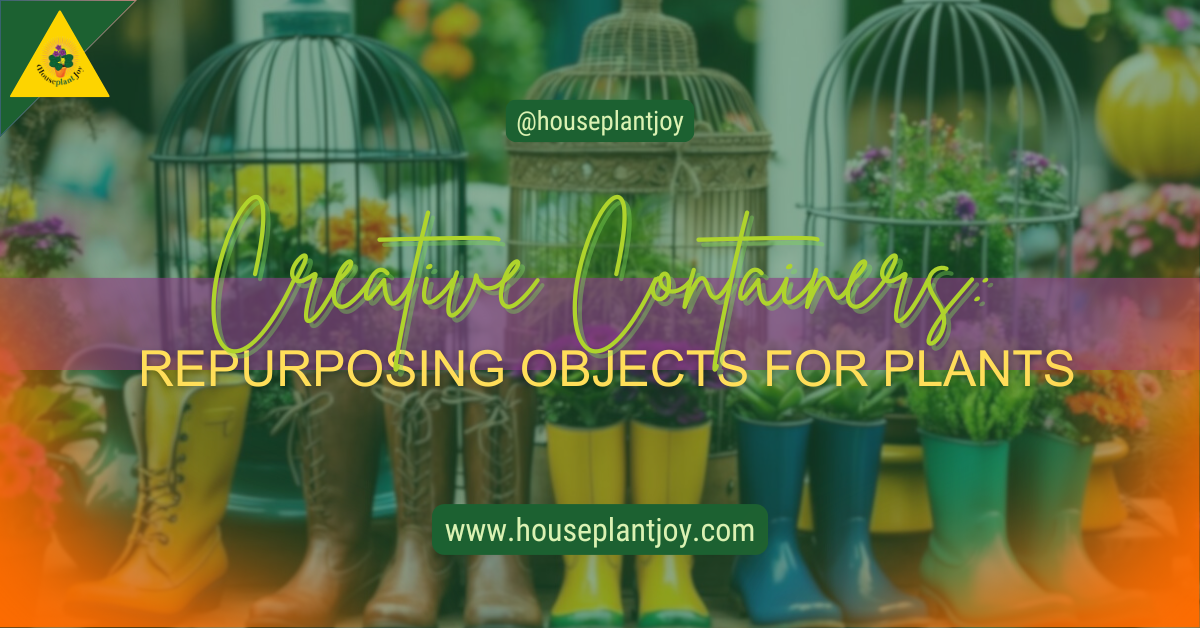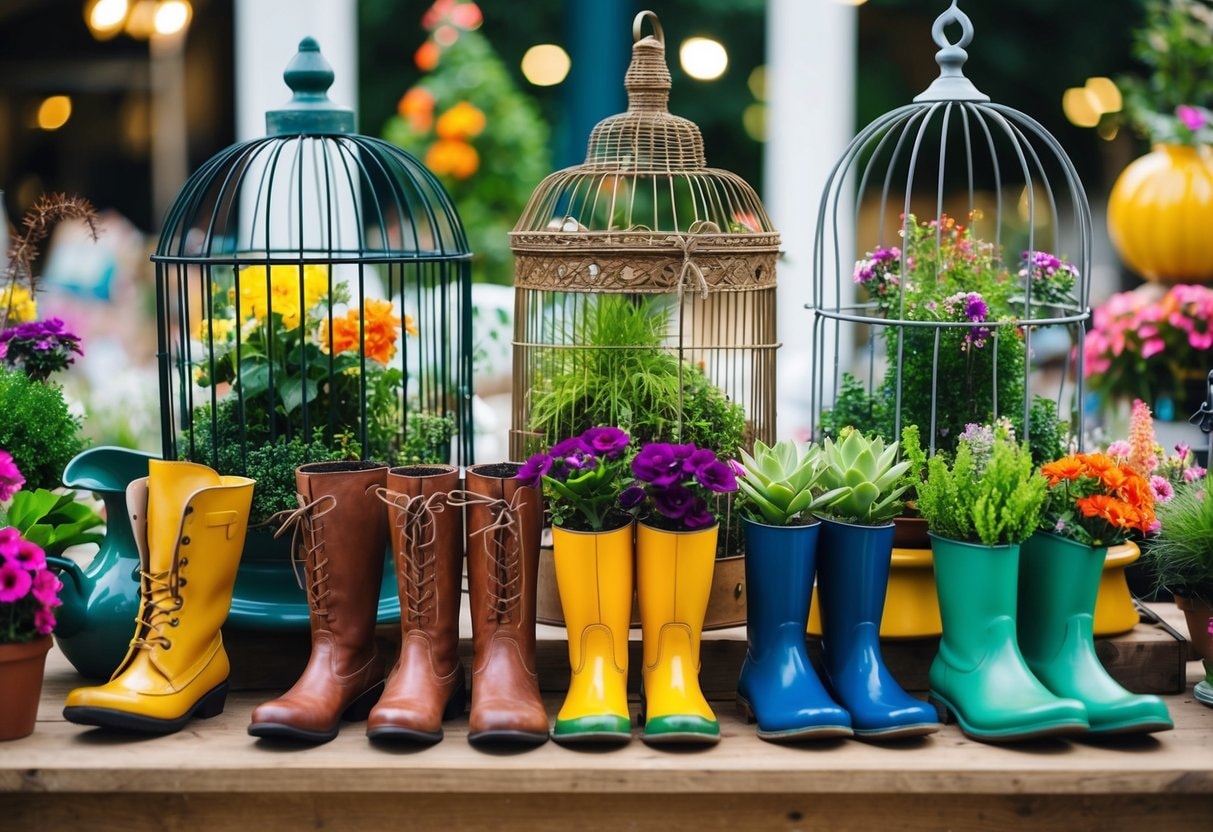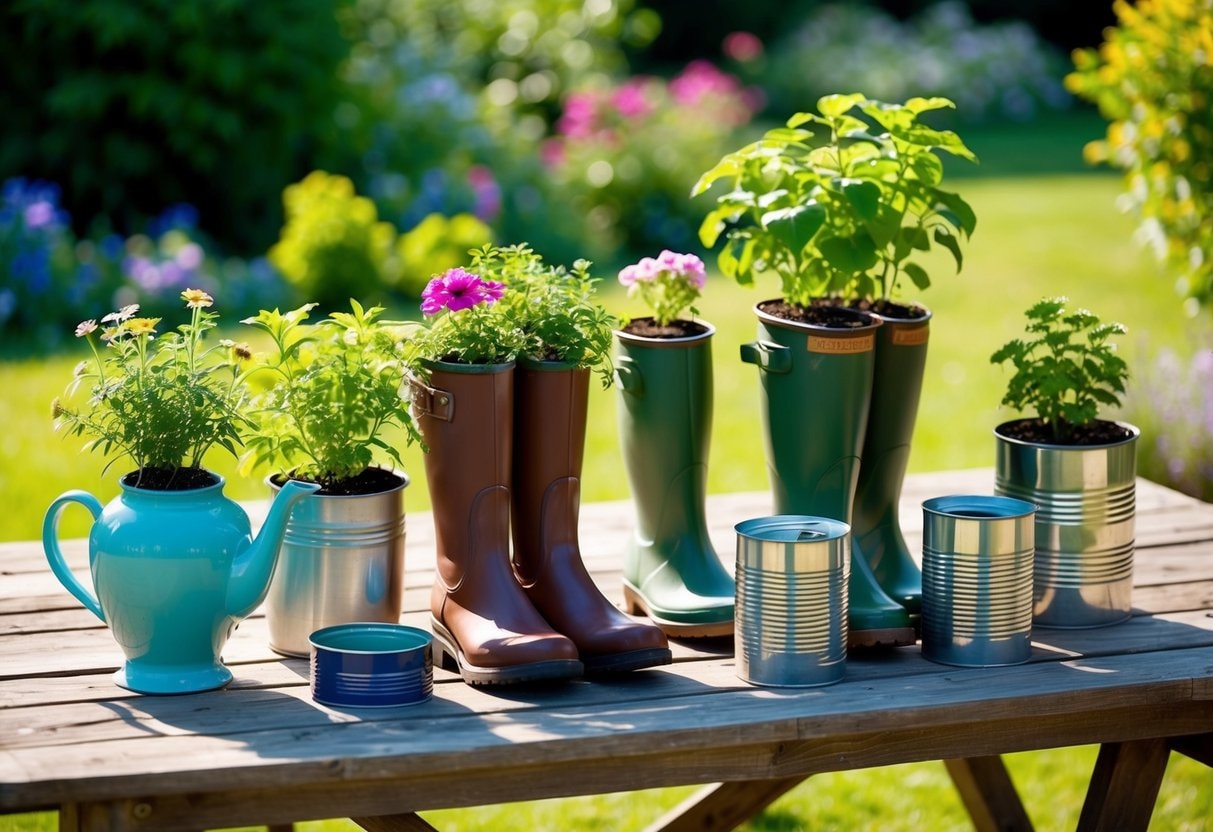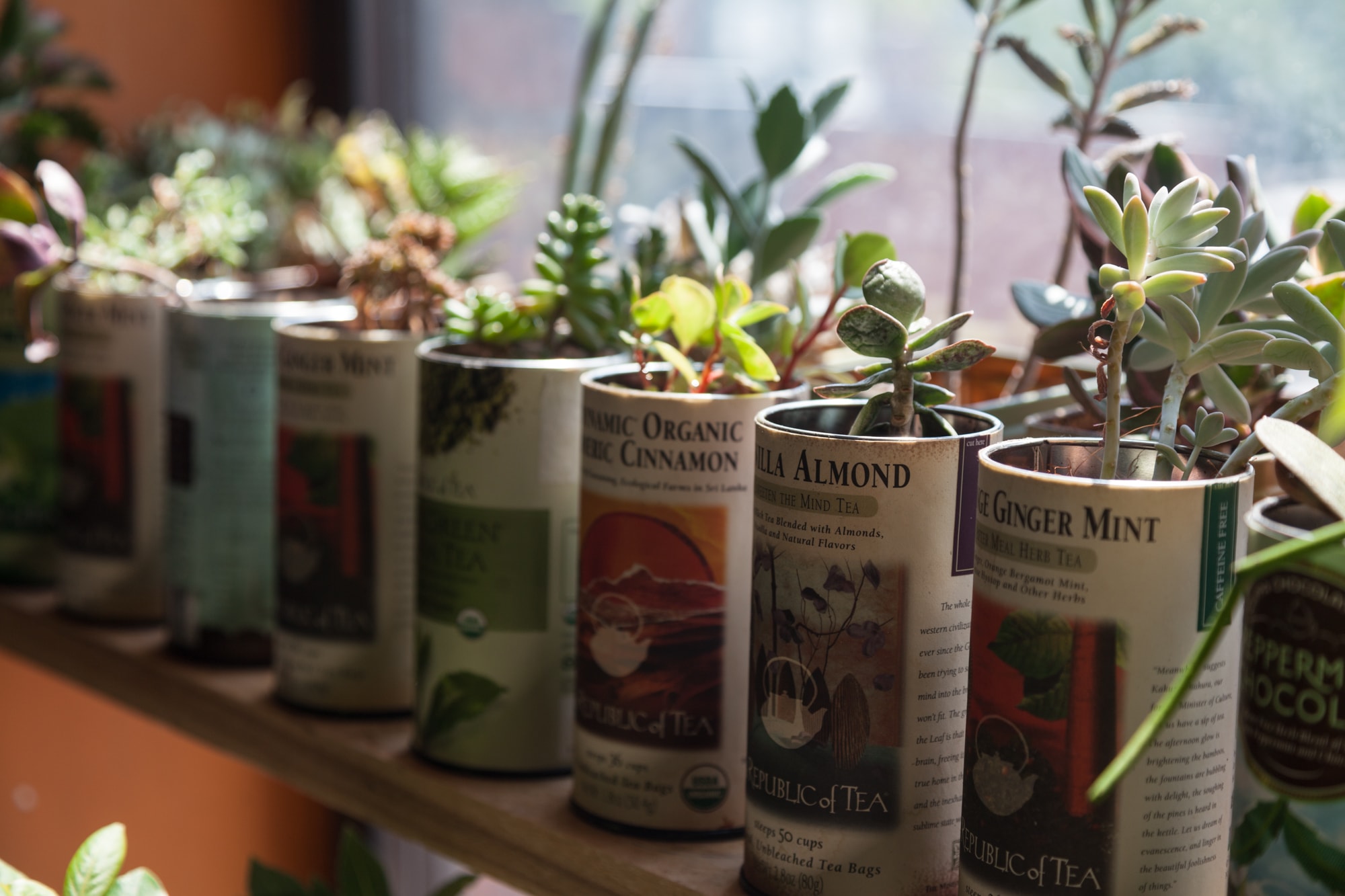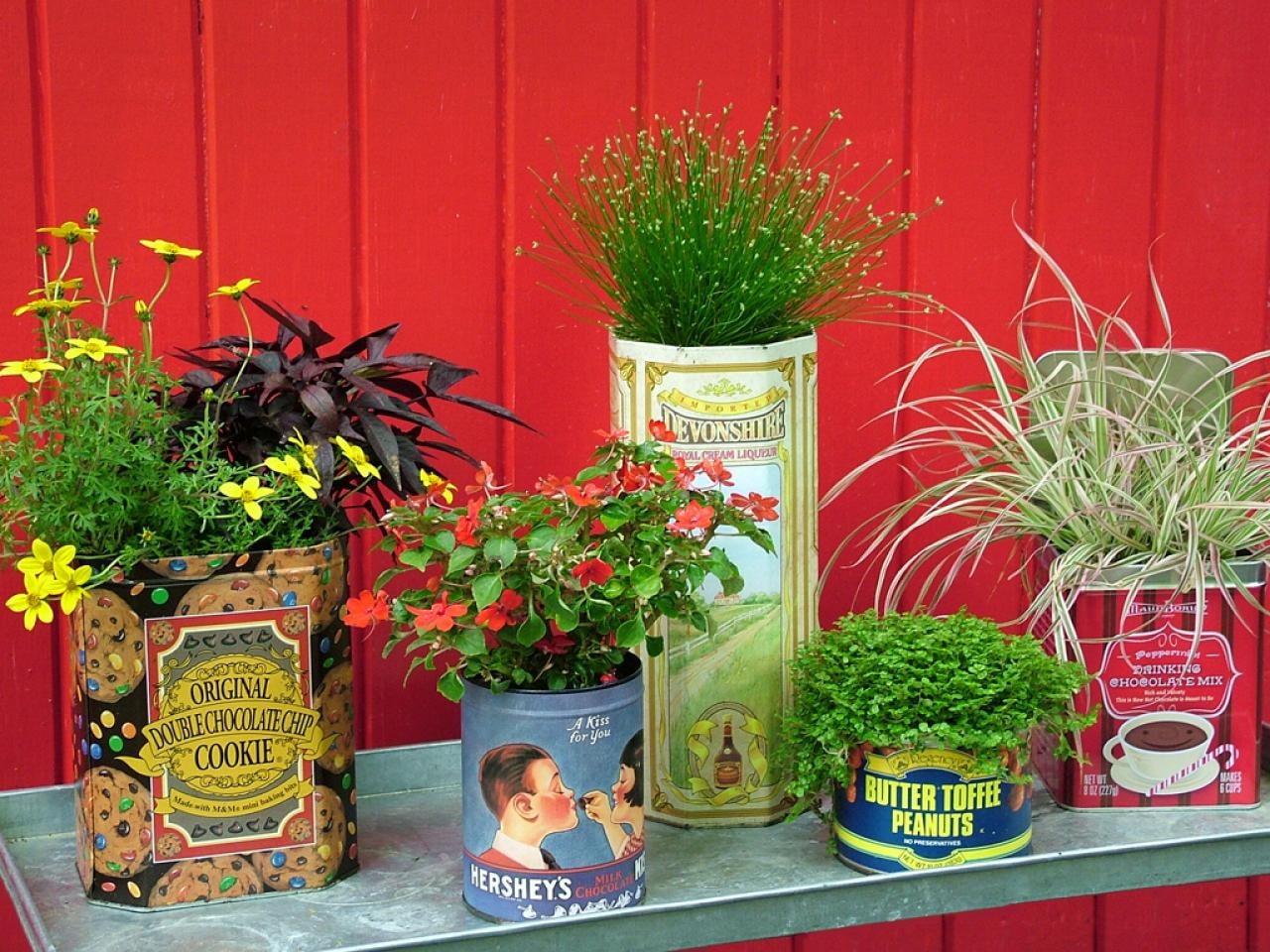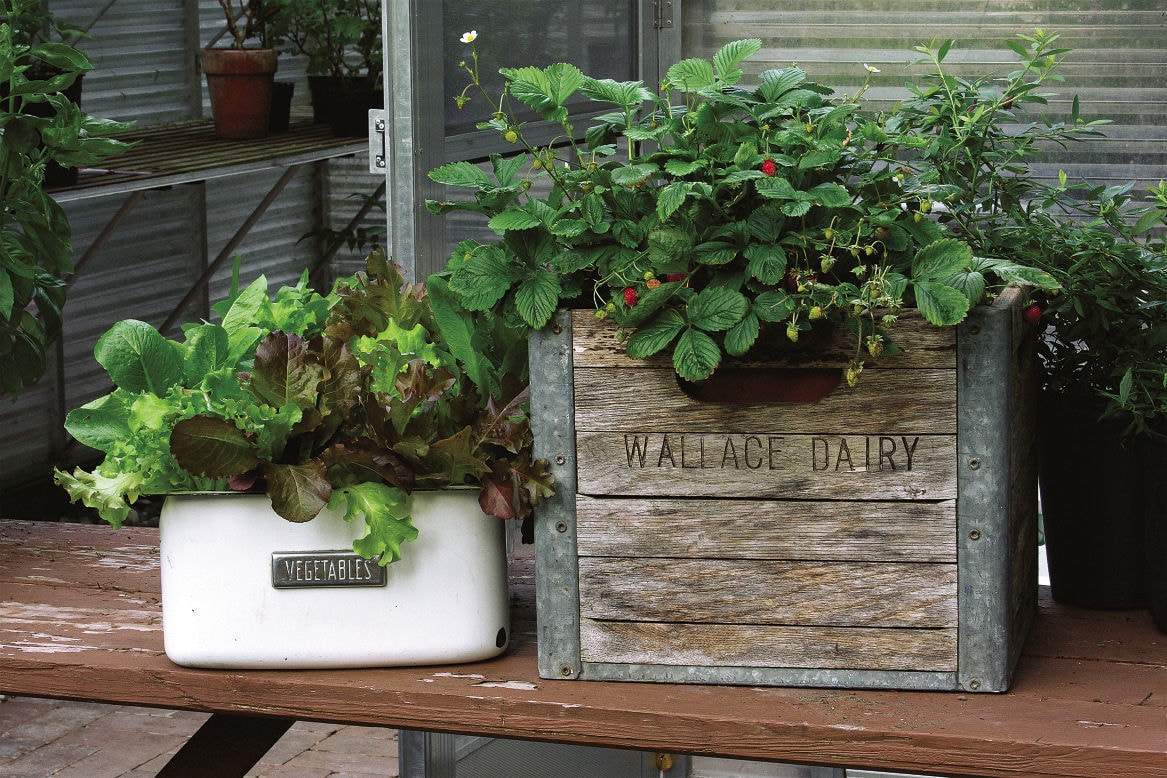HousePlantJoy is supported by our audience. When you purchase through one of our links, we may earn a small affiliate commission. As an Amazon Associate I earn from qualifying purchases. Your cost is not affected.
==================
Creative containers have become a delightful and engaging trend in a world where creativity meets sustainability, transforming everyday objects into unique plant displays. Imagine transforming an old teapot into a charming planter, filling it with vibrant succulents, or taking a vintage wooden crate and converting it into a rustic garden display. Even a weathered bicycle can be an eye-catching vertical garden, showcasing cascading plants that breathe life into your outdoor space. Creative containers elevate your home decor and serve as conversation starters, allowing you to express your individuality and resourcefulness. With the right approach, everyday items can be turned into stunning displays that celebrate your love for plants and your flair for design.
This article delves into a myriad of imaginative ideas for repurposing items you already own, guiding you on cultivating a beautiful indoor oasis while contributing to a greener planet. Whether you’re a seasoned gardener or a novice looking to enhance your living space, you’ll find inspiration in exploring how various materials can take on new life as unique planters. From quirky and whimsical creations to elegant displays that seamlessly blend function with style, discover how to breathe new life into forgotten objects that may be gathering dust in your home. Embrace the thrill of creativity as you craft a stunning visual feast for your plants that captures attention and invites admiration while enriching your surroundings.
Creative Containers: Repurposing Objects for Unique Plant Displays – Turn Everyday Items into Charming Planters
Want to make your garden stand out? Try using creative containers made from everyday objects as plant holders! This fun, eco-friendly approach can turn your outdoor space into a unique showcase. You can create eye-catching displays by repurposing items like old sinks, colanders, and furniture as planters.
Repurposed containers add character and charm to your garden. An old toolbox can become a stylish succulent planter. A vintage lamp might transform into a tall hanging planter. These creative ideas let you express your personality while giving new life to old things.
Using repurposed containers is easy and budget-friendly. Look around your home or visit thrift stores to find valuable items. With a bit of creativity, you’ll soon have a beautiful and unique garden.
Key Takeaways
- Everyday objects like teapots, colanders, and old furniture can be creatively repurposed into charming plant containers, adding unique character to your space.
- Using repurposed containers helps reduce waste and saves money, allowing you to create beautiful plant displays without purchasing new planters.
- Creative containers offer a way to showcase individuality and resourcefulness, making your garden reflect your style.
- When selecting containers, consider their materials, drainage capabilities, and compatibility with your plants’ needs for a harmonious balance of form and function.
Understanding Repurposing
Repurposing means giving an object a new use different from its original purpose. For gardening, this could be turning old shoes into planters or using a vintage teapot as a flower pot. You can repurpose almost anything. Look around your home for unused items like:
- Old buckets
- Broken furniture
- Kitchen utensils
- Worn-out toys
The key is to see the potential in everyday objects. Think about how an item’s shape, size, and material could work as a planter. Before using an object, clean it thoroughly. Make sure it has proper drainage to prevent waterlogging your plants.
Benefits of Repurposing Objects
Using repurposed items as planters has many advantages. It’s a great way to reduce waste and be eco-friendly. You’re giving new life to objects that might otherwise end up in landfills. Repurposing also saves you money.
Instead of buying new planters, you’re using items you already have. These unique containers add personality to your garden. They create talking points and showcase your creativity. Repurposed planters can also:
- Fit your specific needs better than store-bought options
- Allow you to customize your garden’s look.
- Provide a fun DIY project for you and your family.
By repurposing, you’re not just gardening – you’re creating art.
Material Considerations
When picking containers for your plants, think about durability and drainage. Clay pots are great for moisture control but can be heavy. Plastic is lightweight and cheap but may not last as long. Wood adds a natural look but can rot if not treated.
Metal containers are sturdy but may rust over time. The glass is pretty but needs extra care when watering. For outdoor use, pick weather-resistant materials. Indoor displays have more options. Always make sure your container has drainage holes, or add them yourself.
Finding Potential in Everyday Items
Look around your home for unique planter ideas. Old teapots, boots, or even toys can become fun plant homes. Kitchen items like colanders or mason jars work well, too. Broken furniture pieces might make great planters.
An old drawer or bookshelf can hold multiple plants. Even a chipped mug can find new life as a succulent container. Be creative! A vintage suitcase could be a mini garden. A ladder can display climbing plants. The key is to see the potential in items you might otherwise throw away.
Safety and Plant Compatibility
Always clean and disinfect items before using them as planters. This helps prevent plant diseases. Check for harmful chemicals or paints that could leach into the soil. Match plant needs to container size.
Small pots dry out faster, while big ones might lead to overwatering. Some plants need deep roots, and others prefer shallow containers. Consider the weight of soil and water when choosing containers. Make sure shelves or hanging spots can support them. For edible plants, avoid using containers that once held toxic materials.
Balancing Form and Function
Think about how your container will work as a planter. Make sure it can hold soil and drain excess water. You can add drainage holes to items like teacups or old boots. For metal objects, use a liner to prevent rust. Consider the size and shape of your container. It should fit the plant’s needs and your space.
A tall, narrow vase might work well for a snake plant, while a wide bowl is better for succulents. Don’t forget about weight. If you’re using a heavy object, place it where it won’t need to be moved often. Make sure your container isn’t too heavy to support hanging planters.
Color and Texture Harmony
Pick containers that complement your plants and space. You can paint old items to match your decor or create contrast. A bright yellow teapot might pop against green foliage. Mix and match textures for visual interest.
Pair smooth ceramic with rough terracotta or shiny metal. This creates depth in your display. Think about your plant’s colors too. A red colander might look striking with a green fern, while a blue pot could enhance purple flowers.
Creating Focal Points
Use unique containers to draw attention. An old typewriter or vintage suitcase can become a conversation piece. Place these eye-catching planters where they’ll be noticed. Group containers of different heights to create visual flow.
Put taller plants in the back and shorter ones in front. This helps guide the eye through your display. Consider using unexpected items as planters. An old boot or a teacup can add whimsy to your space. Just make sure these items fit with your overall design theme.
Preparing Your Containers
Getting your creative containers ready is key for healthy plants. You must clean, modify, and set up proper drainage to give your green friends the best home. Taking the time to prepare your containers ensures optimal growing conditions and enhances the aesthetic appeal of your unique plant displays.
Cleaning and Sanitizing
Start by giving your containers a good scrub. Use warm, soapy water to wash away dirt and grime. For tougher stains, try a mix of vinegar and water. Rinse well after cleaning. Next, sanitize to kill any harmful bugs or germs.
You can use a bleach solution (1 part bleach to 9 parts water) or hydrogen peroxide. Soak the container for 10 minutes, then rinse thoroughly. Let your container dry completely in the sun. This helps prevent mold growth. You might want to seal wooden containers with a plant-safe wood sealer to extend their life.
Modifying Objects for Drainage
Good drainage is a must for happy plants. If your repurposed container doesn’t have holes, it’s time to make some. Use a drill with a tiny bit for plastic or metal containers to make several holes in the bottom. Space them evenly for best results.
With ceramic or glass containers, you’ll need a particular drill bit. Go slow and steady to avoid cracking. If drilling isn’t an option, add a thick layer of pebbles at the bottom for drainage. Don’t forget to put a saucer or tray under your container to catch excess water.
Layering for Effective Water Management
Proper layering helps manage water and keeps your plants healthy. Start with a layer of small rocks or pebbles at the bottom. This creates space for excess water to drain away from roots. Next, add a piece of landscape fabric or fine mesh. This keeps soil from washing into the drainage layer.
Now for the soil. Use a mix suited to your plants’ needs. For most plants, a general potting mix works well. Add some perlite or vermiculite to improve drainage. Fill your container about 2/3 full with soil. This leaves room for your plant and some top dressing. When planting, make sure the soil level is slightly below the container’s rim to prevent overflow when watering.
Did You Know?
Creating unique upcycled planters on a budget is an exciting endeavor. One can start by checking the kitchen for unused items, such as old teapots, soup tureens, or even large mugs, which can become charming planters for herbs or small flowers. Additionally, visiting thrift stores or yard sales can yield attractive containers like antique buckets, wooden crates, or even old boots. These items can be transformed into one-of-a-kind planters for just a few dollars, allowing for creativity and gardening savings.
Considering Plant Size and Growth Habits
Think about how big your plants will get. Some start small but grow quickly. Others stay compact. Match plant size to your container size. For tall containers, try plants that grow up, like:
- Bamboo
- Snake plants
- Tall grasses
For comprehensive, shallow containers, go for plants that spread out:
- Succulents
- Herbs
- Trailing plants like ivy
Remember to leave room for roots to grow. A hanging planter might work well for plants with smaller root systems.
Choosing Plants for Different Environments
Pick plants that fit where you’ll put them. Sunny spots need different plants than shady areas. For sunny spots:
- Petunias
- Geraniums
- Marigolds
For shady areas:
- Ferns
- Hostas
- Impatiens
Indoor plants need less light. Try:
- Pothos
- Spider plants
- Peace lilies
Think about water, too. Succulents and cacti work great in dry spots. Ferns like it moist.
Seasonal and Permanent Planting Options
You can change your plants with the seasons or pick ones that last all year. Seasonal options:
- Spring: Tulips, daffodils
- Summer: Zinnias, sunflowers
- Fall: Mums, pansies
- Winter: Evergreen branches, berries
For year-round plants, try:
- Evergreen shrubs
- Perennial flowers
- Indoor tropicals
Mix it up! Put spring bulbs under summer annuals. When bulbs fade, annuals take over. Or use permanent plants as a base and add seasonal touches around them.
Creative Ideas and Inspirations
Enable your imagination with creative containers that transform unique plant displays. From everyday items to natural elements, you’ll discover exciting ways to showcase greenery in these innovative vessels. Let’s explore creative ideas to make your plants stand out and enhance your living space!
Upcycled Household Items
Look around your home for objects you can repurpose as planters. Old teapots make charming containers for small herbs or succulents. You can turn a vintage toolbox into a stylish succulent planter. Have an old colander gathering dust? Transform it into a hanging planter. Line it with moss, fill it with colorful flowers, and hang it up for a unique garden display.
Breathe new life into worn-out boots by filling them with soil and plants. They make quirky outdoor planters that add character to your garden. Consider using old wooden crates or drawers for larger plants. Paint them in bright colors to create a fun, rustic look.
Natural Elements as Containers
Bring nature indoors by using organic materials as plant containers. Hollow out an extensive log or tree stump to create a striking planter for ferns or shade-loving plants. Collect interesting rocks or stones and drill holes in them for tiny succulents.
Group several together for a mini rock garden on your windowsill. Use large seashells as planters for air plants or small succulents. They’re perfect for adding a beachy vibe to your decor. Try growing plants in coconut husks or hollowed-out gourds. These natural containers add an exotic touch to your plant display.
Themed Plant Displays
Create a whimsical fairy garden using a shallow dish or an old wheelbarrow. Add miniature houses, tiny furniture, and small plants to bring the magical scene to life. Design a desert-themed display with a glass terrarium. Fill it with sand, rocks, cacti, and succulents to mimic a mini desert landscape.
Make a hanging herb garden using mason jars. Attach them to a wooden board and hang them in your kitchen for fresh herbs at arm’s reach. Put together a tropical paradise in a large glass bowl. Use vibrant, exotic plants and add decorative elements like colorful pebbles or mini figurines.
Maintenance and Care
Keeping your repurposed plant containers in good shape takes some effort. Regular care and quick problem-solving will help your unique planters thrive, ensuring that your creative containers continue to showcase your plants beautifully. By staying attentive to their needs, you can maintain the charm and functionality of these imaginative displays, allowing them to flourish in your home or garden.
Regular Upkeep Tips
Clean your containers often. Wipe them down with a damp cloth to remove dirt and dust. This keeps them looking nice and stops pests from moving in. Check for drainage issues. Make sure water can flow out easily. If needed, add more holes to the bottom of your planter.
Rotate your plants every week or two. This helps them grow evenly and prevents leaning towards light sources. Refresh the soil yearly. Take out some of the old dirt and mix in fresh potting soil. This gives your plants new nutrients to grow.
Troubleshooting Common Issues
- Rust on metal containers: Sand off the rust and paint with rust-resistant paint. This stops the problem from spreading.
- Cracking in wooden planters: Apply wood sealant to prevent further damage. Fill existing cracks with wood filler before sealing.
- Fading colors on painted containers: Touch up with outdoor paint. Use a clear sealant on top to make the color last longer.
- Algae growth: Scrub it off with a mix of water and vinegar. To prevent it, make sure your planter gets enough airflow.
If your plants look unhealthy, check the roots. Repotting might be needed if the roots are crowded or the soil looks terrible.
Indoor Display Strategies
Place your unique containers on shelves or windowsills to catch the light. Group containers of different heights for visual interest. Try using old furniture pieces like dressers or side tables as plant stands. Create a living wall by hanging lightweight containers on hooks.
Old colanders work great for this. Use matching containers for a cohesive look, or mix and match for an eclectic vibe. Don’t forget vertical space. Hang planters from the ceiling or use tall floor lamps as plant stands. A repurposed floor lamp can become a unique vertical garden.
Outdoor Presentation Ideas
Arrange containers on steps or tiered shelves to create levels. This works well for patios and porches. Use larger containers as anchors and surround them with smaller ones. Transform old furniture into garden features. An antique bathtub or wheelbarrow can become a stunning planter. Paint them bright colors to make them pop.
Create themed garden zones using your containers. An herb garden in kitchen items like old colanders or a succulent display in vintage toolboxes adds charm. Hang containers on fences or walls to save space in small gardens. Use sturdy hooks and make sure the plants get enough light.
Promoting Eco-Friendly Gardening
When you reuse items as planters, you cut down on plastic waste. Old tires, wooden crates, and metal colanders make great containers. These choices keep items out of landfills. Opt for natural materials when possible. Clay pots and wooden barrels break down over time without harming the earth.
You can also look for planters made from recycled plastic. These options help reduce your carbon footprint. Water conservation is key in eco-friendly gardening. Choose containers with good drainage to avoid overwatering. You can collect rainwater in old buckets or barrels to water your plants.
Supporting Local Biodiversity
Your repurposed planters can create habitats for local wildlife. Use shallow containers such as bird baths or butterfly puddles. Old teacups or bowls work well for this. Plant native species in your upcycled containers. These plants attract local insects and birds. You’ll help maintain the natural food chain in your area.
Create mini-ecosystems in larger containers. Use old bathtubs or wheelbarrows as pond gardens. These can support frogs, insects, and aquatic plants. Avoid using chemical pesticides. Instead, try companion planting in your repurposed containers. This natural method keeps pests away and supports helpful insects.
Sustainable Style: Transforming Everyday Objects into Stunning Planters
Repurposing everyday objects into creative containers for unique plant displays is not just a trend; it’s a celebration of sustainability and individual expression. This innovative approach allows individuals to transform discarded items into stunning planters, enriching their homes and gardens with character and charm. By giving new life to old teapots, wooden crates, or even weathered furniture, gardeners can showcase their creativity while contributing positively to the environment. This journey of creativity can also inspire meaningful conversations, as each unique planter tells a story and reflects the personality of its creator.
As one explores the world of creative containers, endless possibilities unfold. Whether seeking whimsical, elegant, or rustic designs, the potential for creativity is limited only by one’s imagination. The experience of crafting unique plant displays becomes a rewarding adventure, combining artistry with eco-consciousness. As you delve into this rewarding practice, remember that every repurposed item has the potential to become a beautiful home for your plants, enriching your space and spirit. Embrace the art of repurposing and let your plant displays reflect your unique style and love for nature.
What Are Some Innovative Ways to Repurpose Household Items Into Plant Containers?
Are There Alternative Uses for Large Garden Planters Apart From Displaying Flowers?
Can You Suggest Some Uncommon Objects That Can Be Transformed Into Plant Displays?
Where Might One Find Inspiration for Diy Planter Ideas Using Recycled Materials?
How Do I Ensure Proper Drainage in Creatively Repurposed Plant Containers?
Why Join Our Community?
Discover Exclusive Insights: Unlock valuable tips to help your plants flourish and grow.
Professional Guidance: Get in touch with our expert team through Facebook, Twitter, and more. Our gardening pros are here to support you every step of the way on your plant care journey.
Connect with Fellow Plant Lovers: Share your experiences and connect with like-minded enthusiasts. Be a part of a nurturing community today! Follow Houseplant Joy on Facebook, Instagram, and Twitter for daily inspiration and to enhance your plant-growing experience! #HouseplantJoy #GreenThumbsUnite #HouseplantLove

